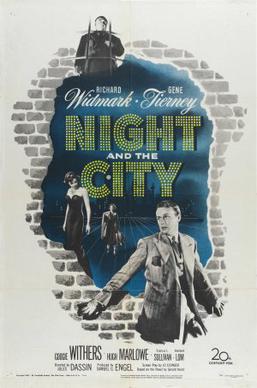A director with over 20 credits to his name, Jules Dassin has his fair share of classics and memorable movies. But as a director, he hit his stride and reeled off a crazy list of film noir successes in the late 1940s including Brute Force, Thieves' Highway, The Naked City, and welcoming in the new decade, 1950's Night and the City.
An American living in London and trying to make things work with his longtime girlfriend, Mary (Gene Tierney), Harry Fabian (Richard Widmark) wants nothing more than to make it big and make a name for himself. The only problem? Harry has no real charm or talent to do it other than his own charm. In other words, he's a hustler and a con man, always looking for the big thing that will rocket him to the top. In debt and in trouble, Harry might finally have found his in. He meets Gregorious (real-life strongman/wrestler Stanislaus Zbyszko), an internationally renowned wrestler trying to build up the wrestling community/shows in London. It seems like a sure thing, an easy way to make a ton of money, but there's another problem. Gregorious' son, Kristo (Herbert Lom), already has a stranglehold on London wrestling and isn't going to give it away easily.
Released in the heyday of the film noir, 'City' has a trump card that makes it different (and better) from many other noirs of the time. I always think of noirs as taking places in NYC, Los Angeles, any number of small, grimy American towns with all sorts of shady dealings going on in the back alleys. As for this film? Dassin doesn't film his noir in a studio or back lot, he shot on location in and around London. It's a great look to the film, giving the sense of another character in the already incredibly dark story. Sure, much of the story takes place inside (in a studio), but whenever possible, Dassin shot on the streets, alleys, docks and landmarks of London. Filming in black and white, Dassin plays on the usual noir conventions -- darkness, smoke and shadows -- and transports it to London. It's a beyond perfect choice.
Another convention of the noir genre is the general nastiness of the world. Anyone and everyone is looking out for themselves. In other words, always watch your back. Even in the nastiest of movies, there was always that one beacon of light, one good person. Beyond a poor dock owner (Maureen Delaney) who's mixed up in the black market but a good person, there's nary a redeemable character anywhere in sight. In terms of story alone, this is easily one of the darkest, most cynical film noirs I've ever seen. We see the London criminal underworld in all that darkness. But with a talented director like Dassin behind the camera, it's an incredibly stylish if dark look at that world. Dassin uses his camera like few other directors of the time did, including one tracking shot from the back of an open-top convertible navigating London at night. It's a very simple, straightforward scene, but it looks great, and it was certainly far ahead of its time in style.
Still carving out a name for himself as an actor after the star-making role in Kiss of Death, Widmark again shows a knack for playing less than sympathetic characters (if significantly psychotic than Tommy Udo). If there was ever a doomed character in a film noir, Widmark's Harry Fabian has to be near the top of the list. The best part? He's not completely unsympathetic. Harry desperately wants to be something, but he's got no actual way to do it. Instead, he cons, hustles, talks and connives his way into everything he wants and needs. Widmark does a great job showing both sides of this character, but it's apparent from the start where things will end up. In his desperation, Harry simply pushes too far, pitting both sides against each other, and his precarious house of cards hangs in the balance. Another above average performance from a rising star.
And then there's the rest of the nastiness, a whole bunch of similarly despicable characters with their eyes always on the cash. Fabian works for Phillip Nosseross (Francis L. Sullivan), a condescending, immense man who owns a successful night club (maybe a strip club of sorts) with his wife, Helen (Googie Withers). She's also working with Fabian -- behind her husband's back -- to open up a nightclub with a forged license. In a smaller but still effective part, Lom is an ideal intense villain who does have a bit of a human side (however limited). The real-life strongman, Zbyszko is a natural on-screen, a scene-stealer as Gregorious, trying to create a name for a young Greco-Roman wrestler, Nikolas (Ken Richmond). His part is also highlighted by a brutal, knock-down fight with a rival wrestler, the Strangler (Mike Mazurki). Another halfway decent person is Hugh Marlowe's Adam, Mary's neighbor who may have his eyes set on her. Those are the big parts, but even the bit parts are nasty, all of which we see as Harry explores London.
I liked this one a lot right from the start. The only weakness comes in the finale. It's far from slow-moving, but the pacing takes a little time getting to where it wants to be. The issue is that anyone with a working brain knows exactly where it's going. It's not enough to ruin the movie -- not by a long shot -- but it's a minor flaw worth pointing out. An otherwise excellent film noir with a great cast, great look and perfect use of on-location shooting.
Night and the City (1950): ***/****


No comments:
Post a Comment